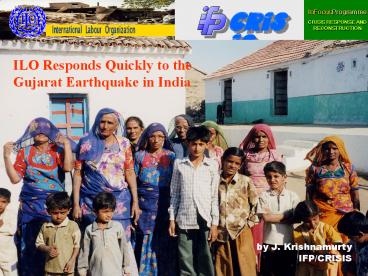ILO Responds Quickly to the PowerPoint PPT Presentation
1 / 11
Title: ILO Responds Quickly to the
1
ILO Responds Quickly to the Gujarat Earthquake in
India
by J. Krishnamurty IFP/CRISIS
2
The Impact of the Earthquake
- The affected population is about 16 million, more
than twice the population of Switzerland. - The total loss of property has been placed at US
4.6 billion - The death toll is now estimated at around 30,000.
More than 165, 000 people were injured. - Some 330,000 houses were destroyed and another
750,000 were damaged. - The immediate job losses and reduction in
employment opportunities over the year have not
yet been estimated.
3
The International Response
- The World Bank and the Asian Development Bank
have provided about US700 million for the
reconstruction programme. - Other governments and international NGOs have
also directly assisted through projects and
programmes. - The United Nations is coordinating the relief
efforts of 250 organizations within and outside
of the UN system and has committed US50 million
to the effort.
4
The National Response
- The national and State governments have mobilized
financial and real resources on a massive scale
to address the problem. Other States in India
have also assisted Gujarat. - Apart from private philanthropy, the corporate
sector, employers organizations, chambers of
commerce and groupings of industry will take part
in rebuilding the economy of the affected region. - Workers and their organizations have contributed
to the effort by donating, in many enterprises,
one days earnings, matched by employers
contributions. Unions and their members have
also directly contributed to the relief effort.
5
The ILO and Crises
Crises test our resolve to provide women and men
decent work in conditions of freedom, equity,
security and dignity. The ILO response has to
both coherent and rapid
- we need to develop a package of interventions
which matches the expressed needs of our
constituents and contributes to the efforts of
the affected population to maintain dignity and
self-reliance. - we need to pick on our strengths and select
interlinked activities that fall within our
mandate. - we need to design interventions and select
partners in such a way that our response is truly
rapid.
6
The Immediate ILO Response
- Jointly with the ILO Area Office in New Delhi,
the InFocus Programme on Crisis Response and
Reconstruction at headquarters responded within
days to the disaster by fielding three
consultants to assess the situation and come up
with suggestions and project ideas. - This was followed up by missions by IFP/CRISIS
and GENPROM from headquarters to develop a rapid
response intervention with SEWA to promote
shelter and livelihoods, and to initiate other
activities.
7
Some Obstacles
- The humanitarian assistance community does not
often recognize that a major and immediate impact
is the loss of employment and income-earning
opportunities and related social and economic
distress for significant sections of the
population hit by the disaster. - ILOs capacity to contribute right from the
start, to relief, reconstruction and development
is still not widely known to the humanitarian
agencies.
8
Some Positive Outcomes
- The presence of our national consultants in the
disaster area within days of the earthquake
provided the ILO with a field presence and an
opportunity to articulate ILO concerns in local
level discussions with other key national and
international actors. - Other agencies like the IOM, WFP and UNICEF have
noted our early presence and work and have shown
interest in collaborating with us.
9
What Next?
The New Delhi Office, with the assistance of the
IFP/CRISIS and GENPROM, has put together a
package of inter-related measures to address the
crisis, focussing not only on recovery and
reconstruction, but also on the return to
development.
- The objective is
- to provide a quick response based on an
assessment of the situation. - to concentrate on what the people immediately
need.
10
The Package
- The package includes
- A model programme for social and economic
reconstruction for 10 villages in Kutch District,
funded by the ILO and implemented by SEWA. - Further measures to promote labour-intensive
reconstruction, including linking with major
programmes for reconstruction. - A study of the response of the corporate sector
to the relief and rehabilitation needs. - Studies of the impact of the earthquake (coming
after successive years of drought in the region)
on employment, poverty, migration, insecurity and
coping mechanisms.
11
Thank you

